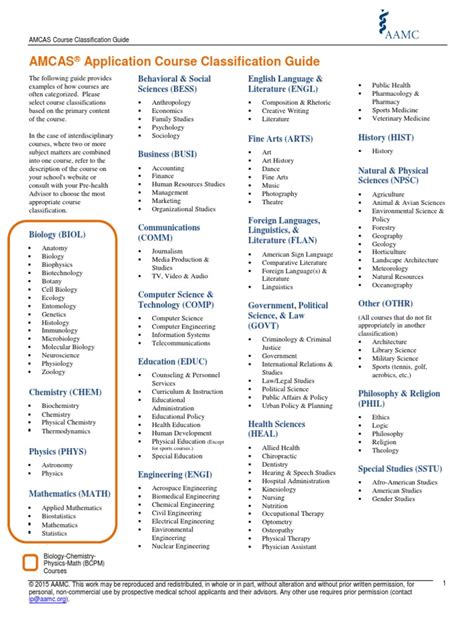Introduction

The American Medical College Application Service (AMCAS) is the centralized application platform used by medical schools in the United States. As part of the application process, students are required to categorize their coursework according to AMCAS’s specific course classification system. This can be a daunting task, especially for students with complex academic backgrounds.
This comprehensive guide will provide you with a detailed overview of the AMCAS course classification system, including its purpose, classifications, and step-by-step instructions on how to classify your courses. By understanding and adhering to these guidelines, you can ensure that your medical school applications are accurate, complete, and ready for review.
Purpose of AMCAS Course Classification
The AMCAS course classification system serves two primary purposes:
- Standardization: It categorizes courses into standardized groups, allowing medical schools to compare academic credentials across applicants from different institutions and educational systems.
- Evaluation: The classification system helps medical schools evaluate an applicant’s academic preparation, particularly in the science and math coursework required for medical school.
AMCAS Course Classifications
The AMCAS course classification system consists of the following categories:
| Category | Subcategory | Course Type |
|---|---|---|
| Biological Sciences | Biology | General biology, molecular biology, biochemistry, cell biology |
| Chemistry | Inorganic chemistry, organic chemistry, biochemistry | |
| Physics | Physics I, Physics II, Physics III | |
| Mathematics | Mathematics | Algebra, calculus, statistics |
| Social Sciences | Social Sciences | Sociology, psychology, economics |
| Humanities | Literature, history, philosophy | |
| Other | Foreign Language | Not offered in English |
| Other | Courses not covered by other categories |
Step-by-Step Course Classification
Step 1: Gather Your Transcripts
Collect your official transcripts from all colleges and universities you have attended.
Step 2: Identify Course Titles
Review your transcripts and identify the titles of all courses you have completed.
Step 3: Match Courses to Categories
Refer to the AMCAS course classification table above to determine the appropriate category for each course.
Step 4: Categorize Courses in AMCAS
Once you have classified your courses, enter the categories into the AMCAS application portal.
Step 5: Review and Submit
Carefully review your course classifications to ensure accuracy and completeness before submitting your application.
Tips for Classification
- Consider Course Content: Focus on the primary content of the course rather than its title when categorizing.
- Use Common Sense: If a course does not clearly fit into a category, consider its closest alignment.
- Consult with Faculty: If necessary, reach out to faculty members for guidance on course classification.
- Inquire at AMCAS: If you have any questions or concerns, contact AMCAS for assistance.
Additional Considerations
- AP and IB Courses: College-level courses taken in high school, such as Advanced Placement (AP) or International Baccalaureate (IB) courses, should be classified as college coursework.
- Pass/Fail Courses: Pass/fail courses are not included in the AMCAS GPA calculation but should still be classified.
- Prerequisite Courses: Courses that are prerequisites for medical school, such as anatomy and physiology, should be classified as Biological Sciences courses.
- Multiple Cross-Listed Courses: If a course is cross-listed in multiple departments, categorize it based on its primary content.
Conclusion
The AMCAS course classification system is an important aspect of the medical school application process. By understanding and following the guidelines outlined in this guide, you can ensure that your courses are accurately categorized, allowing medical schools to fully evaluate your academic qualifications. Remember to consult the AMCAS application portal and seek guidance from faculty or AMCAS if necessary. With careful attention to detail, you can submit a complete and competitive application that will increase your chances of success.
